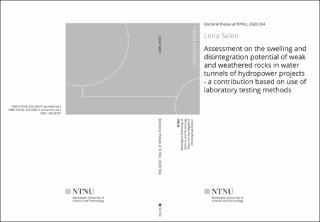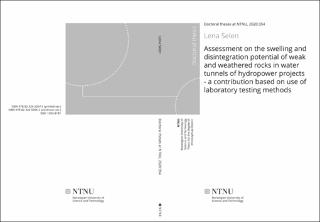| dc.contributor.advisor | Panthi, Krishna Kanta | |
| dc.contributor.advisor | Stokseth, Siri | |
| dc.contributor.author | Selen, Lena | |
| dc.date.accessioned | 2020-11-06T08:44:30Z | |
| dc.date.available | 2020-11-06T08:44:30Z | |
| dc.date.issued | 2020 | |
| dc.identifier.isbn | 978-82-326-5055-2 | |
| dc.identifier.issn | 1503-8181 | |
| dc.identifier.uri | https://hdl.handle.net/11250/2686655 | |
| dc.description.abstract | Swelling of rocks is a time-dependent phenomenon and a result of multiple and interactive rock characteristics interplaying in a complex picture. Further, the swelling responses of the rock mass are conditioned on the project-specific phases of operation and the consequential changes in rock material characteristics over time. Assessments on the swelling character and state of degradation of rocks are therefore fundamental in avoiding difficulties in tunnels constructed for both infrastructure and hydropower. Since testing of insitu rock masses on a realistic scale is difficult to conduct due to excessive costs and resources, the prediction of rock mass behavior to a large extent must rely on laboratory assessments on sampled rock specimen.
Despite the large number of testing procedures and classification systems of rocks, the different methods suggested for assessments on the weak and intermediate rock types are not univocal. Further, testing programs conventionally used in rock mechanics are found difficult to apply on weak rocks due to preparation issues, and procedures used in soil mechanics tend to neglect important material parameters of the intact rock. In addition, the project-specific aspects of rock behavior are usually discounted in standardized test procedures as this will reduce the applicability of the classification system across engineering disciplines. Major generalizations are therefore prevailing in many widely used investigation procedures.
An increasing number of cases reported from the hydropower industry witness about instabilities and collapses whereby swelling and disintegration of degraded rocks are among the causes. Several of the cases are assumed related to a mismatch between the estimated rock characteristics and the experienced behavior of the in-situ rock mass, which is a serious challenge as the adequacy of the support system is dependent on factual input data to modeling tools. However, the intense exposure to moisture fluctuations in hydropower water tunnels passing through weak rock masses are seldom addressed in the applied laboratory tests. Considering the current need of understanding the mechanisms causing swelling and slaking behavior of degraded rocks, this research aims to examine frequently used investigation strategies applied in weak rock engineering with emphasis on water tunnels for hydropower projects.
The research work includes literature reviews, field work, laboratory visits, sampling and testing of rock specimens. Based on close cooperation with different institutions, i.e.; Statkraft, SINTEF, NGI (Norges Geotekniske Institutt), KIT (Karlsruhe Institute of Technology) and Politecnico di Torino, inside information on investigation strategies in weak rock assessments is obtained. The testing procedures used at three European institutions for determination of rock material parameters as mineralogical composition, structural features, swelling potential and slake durability are assessed down to single detail. Rock specimens from two hydropower projects are sampled, prepared and tested at KIT and NTNU. The processing of the obtained data is based on both quantitative analyzing methods and qualitative descriptions and comparisons. In addition to the industrial partners of this research, continuous discussions with research colleagues, both domestic and abroad, are performed during the entire research period.
The findings of this research imply that the frequently used ISRM (International Society for Rock Mechanics) suggested methods for assessments on swelling potential and slake durability of rocks needs adjustments when applied on weak and intermediate rock types. The oedometer swelling test for assessments on swelling gouge material in weakness zones are found inadequate in characterizations of intact rock swelling properties. Limitations are also revealed on the general consistency of the testing manuals, on the preparation techniques, on the apparatus configurations, on the temperature exerted on the samples during both preparation and testing, and on the interpretation systems for the results. Further improvements on the methodologies are found necessary when applied in determinations of the long-term degradation behavior of weathered and swelling rocks in hydropower projects. In addition, major weaknesses are found for the X-Ray Diffraction (XRD)-analysis used to quantify mineralogical constituents when applied on weathered rocks.
The extensive laboratory work in combination with the wide-ranged cooperation has resulted in suggestions on project-specific modifications on standardized laboratory tests which enable an interpretation of weak rock behavior closer to the in-situ situation of water tunnels. Improvements are made explicit on the oedometer swelling test procedure in operation at the NTNU laboratory, including preparation techniques and apparatus configuration, and investments on new equipment is in progress. Additionally, the research includes an experimental application of the in-situ flatjack test normally used to measure in-situ stresses around tunnels which now is installed in a hydropower tunnel to measure changes in stress during the initial phase of operation. The flatjacks will hopefully produce valuable data for comparison with and evaluation of the obtained laboratory results. The overall findings are highly relevant for the hydropower industry but may also be relevant for other geotechnical projects where weathered and swelling rock materials cause challenges related to construction and/or operation of geotechnical structures. | en_US |
| dc.language.iso | eng | en_US |
| dc.publisher | NTNU | en_US |
| dc.relation.ispartofseries | Doctoral theses at NTNU;2020:354 | |
| dc.relation.haspart | Paper 1. Selen, Lena; Panthi, Krishna Kanta; Vistnes, Gunnar. An analysis on the slaking and disintegration extent of weak rock mass of the water tunnels for hydropower project using modified slake durability test. Bulletin of Engineering Geology and the Environment 2020 ;Volum 79.(Issue 4) s. 1919-1937
https://doi.org/10.1007/s10064-019-01656-2
This article is distributed under the terms of the Creative Commons Attribution 4.0 International License (http://creativecommons.org/licenses/by/4.0/), | en_US |
| dc.relation.haspart | Paper 2:
Selen, Lena; Panthi, Krishna Kanta; Vistnes, Gunnar.
An investigation on the compositional features and swelling potential of two weak rock types affecting their slake durability | en_US |
| dc.relation.haspart | Paper 3: Selen, Lena; Panthi, Krishna Kanta; Vergara, Maximiliano R.; Mørk, Mai Britt Engeness. Investigation on the Effect of Cyclic Moisture Change on Rock Swelling in Hydropower Water Tunnels. Rock Mechanics and Rock Engineering.
https://doi.org/10.1007/s00603-020-02266-1
This article is distributed under the terms of the Creative Commons Attribution 4.0 International License (http://creativecommons.org/licenses/by/4.0/), | en_US |
| dc.relation.haspart | Paper 4:
Selen, Lena; Panthi, Krishna Kanta.
A discussion on the laboratory testing approaches for swelling rocks at three European institutions | en_US |
| dc.relation.haspart | Paper 5:
Selen, Lena; Panthi, Krishna Kanta; Tunbridge, Lloyd; Schönborn, Thomas.
Field testing of weak rock deformation in water tunnels: A practical review of the flatjack test. I: Rock Mechanics for Natural Resources and Infrastructure Development. CRC Press 2019 ISBN 978-0-367-42284-4. s. 1716-1723
https://doi.org/10.1201/9780367823177 | |
| dc.title | Assessment on the swelling and disintegration potential of weak and weathered rocks in water tunnels of hydropower projects - a contribution based on use of laboratory testing methods | en_US |
| dc.title.alternative | Assessment on the swelling and disintegration potential of weak and weathered rocks in water tunnels of hydropower projects - a contribution based on use of laboratory testing methods | en_US |
| dc.type | Doctoral thesis | en_US |
| dc.subject.nsi | VDP::Technology: 500::Rock and petroleum disciplines: 510::Petroleum engineering: 512 | en_US |

